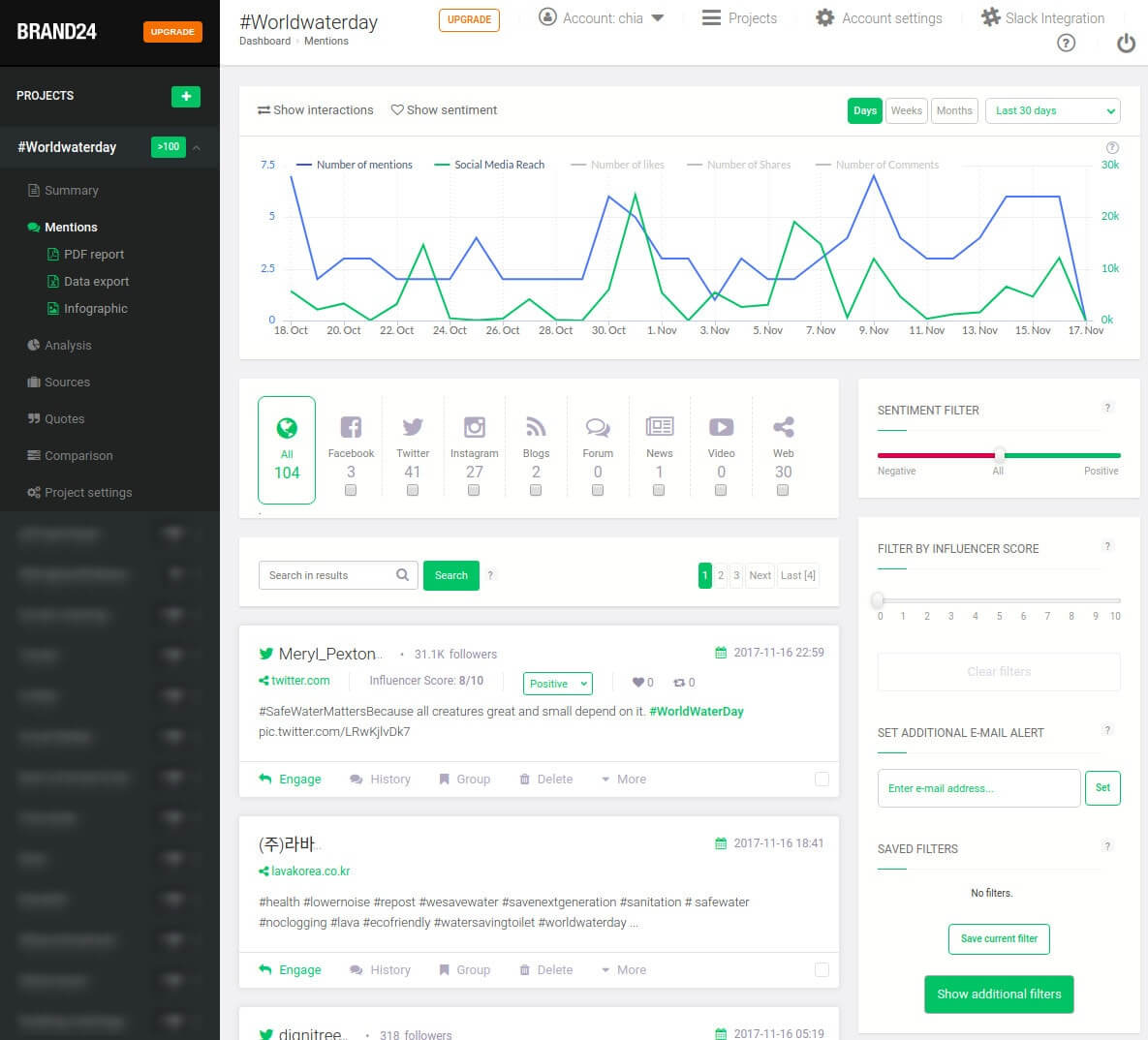How to Create a Hashtag That Will Trend?
Knowing how to create a hashtag that will trend is a fundamental marketing skill. Hashtags are amazing business tools for generating buzz about your campaign, event, or special promotion, finding leads, increasing brand awareness, and much more.
Used correctly, hashtags can spark conversations and carry brand messages to audiences across platforms. This flexibility is part of what makes them so appealing.
Keep track of how often your hashtag is used to monitor its performance.
A media monitoring tool like Brand24 will not only count the number of times your own hashtag is used, but also automatically collect & display each usage inside your account.
Hashtags aren’t exactly rocket science, but there are a few things to keep in mind if you want to create a branded hashtag that’s user-friendly. From capitalization to double-entendres, to finding the perfect balance between being too specific and not specific enough, here are a few tips on how to create a hashtag for your campaign.
Follow these steps to create a trending hashtag:
- Step 1. Create a hashtag that’s short (and simple)
- Step 2. Create a hashtag that’s easy to read
- Step 3. Consider all the ways your branded hashtag could be (mis)understood
- Step 4. Don’t use too many hashtags in one post
- Step 5. Do your research when using other hashtags
- Step 6. Create own hashtag that’s original
- Step 7. Create a hashtag that’s actionable
- Step 8. Brainstorm your branded hashtags
- Step 9. Promote your hashtag
- Step 10. Join in on conversations using your hashtag
- Step 11. Monitor your hashtag
Step 1. Create a hashtag that’s short (and simple)
Hashtags are not overly complicated, nor should they be.
Don’t be afraid to get creative, but keep it simple enough so that your audience can easily repeat & reuse, like Coca Cola did with #ShareACoke:
Social media campaigns with short and easy branded hashtags are more memorable and more likely to trend.
Step 2. Create a hashtag that’s easy to read
#CapitalizingTheFirstLetterOfEachWord makes your hashtag much easier to read. BUT also see what it looks like using all lowercase letters. This will help you avoid hashtag fails like the infamous #susanalbumparty.
Capital letters make longer hashtags easier to read and are less likely to confuse people as shown on the example above.
Track hashtags with Brand24, the best social listening tool.
Step 3. Consider all the ways your branded hashtag could be (mis)understood
Make sure that your company doesn’t get caught in the crossfire of any miscommunication. Check current events. Check events from 2 seconds ago. And beware of double-entendres, unless that’s what you’re going for:
This step is strictly connected with the previous one. Using capital letters should usually help avoid confusion, but to be 100% sure I recommend showing your unique hashtag to someone else before posting it the first time.
Step 4. Don’t use too many hashtags in one post
It might be tempting to try to reach the widest audience possible by slapping on 20 different hashtags – in addition to your own. But so many hashtags in one post can look spammy. Only use other hashtags that are relevant to your content. Plus, some platforms have strict character limits.
If there are really 20 relevant hashtags that you just have to use in one post, hide them. How? Most platforms like Instagram, LinkedIn, and Facebook will only display the first couple lines of text. Anything below that gets hidden and readers have to click ‘more’ to see it.
Make sure your readers see your hashtag, but hide the rest if you have an entire fleet to avoid posts that look like this:

Most social media specialists recommend using up to 15 different hashtags in Instagram posts. Twitter has a 280 characters limit that will heavily narrow your hashtagging choices. Try yourself various combinations with different potential hashtags and you will see what strategy works best for your personal brand.
Read:
Step 5. Do your research when using other hashtags
Some hashtags appear general like they could be applied to anything. This gives them versatility, but also makes them prone to misuse. That’s why it’s important to do your research before using pre-existing hashtags.
DiGiorno’s learned this the hard way when they Tweeted: ‘#WhyIStayed You had pizza.’ Under normal circumstances, this would’ve been a clever Tweet. Unfortunately, the hashtag #WhyIStayed had been created for a domestic violence campaign. DiGiorno’s soon deleted the Tweet and apologized, but not before some angry netizens took notice of it.
When you do use your hashtag together with others, make sure you do your research first.
Step 6. Create own hashtag that’s original
It’s common practice for companies to piggyback on pre-existing hashtags; it helps new and larger audiences find your content and you don’t have to build a hashtag user list from scratch.
However, if you’re planning on launching a marketing campaign on a larger scale that’s powered (at least in part) by a hashtag, take the time to create a customized hashtag that people will associate with your brand. You’ll be using it to spark conversations and help carry the message in your campaign.
Don’t worry, with my instructions you will ultimately learn how to create a hashtag that will definitely trend.
Step 7. Create a hashtag that’s actionable
The whole point of creating a hashtag is to generate buzz. The best way to do that is by inspiring action. Hashtags that activate people and motivate them to act in some way are super effective.
Whether your hashtag invites audiences to #ShareAStory or even if it’s more #FoodForThought, make sure there’s an actionable component involved.
One of my favorite hashtag campaigns is from Red Bull, with #PutACanOnIt. It encouraged their audience to get creative and produced a lot of fun user-generated content across platforms.

What do you want people to talk about? What do you want them to do? What do you want your brand to be associated with? Always encourage customers to #TakeAction.
Step 8. Brainstorm your branded hashtags
Now it’s time to think about the wording behind the hashtag itself. Do you have a slogan for your marketing campaign? You can use the same slogan for your hashtag. But if your hashtag campaign is focused on a smaller aspect of your campaign, you may want to come up with something different.
Your hashtag doesn’t have to be branded, and it doesn’t have to be the perfect blend of wit and creativity either. Nope – it just has to help deliver your message.
Make sure that your hashtag supports the underlying theme of your campaign.
Step 9. Promote your hashtag
Let people know about your hashtag! Write about it on your social channels, use it in your newsletters, on your blog, and maybe even in your customer communications. The point is: people can’t use your hashtag if they don’t know about it, so tell them about it! Like Charmin’ did with #Tweet4ATree:
Your unique hashtag should be visible literally everywhere if you want it to trend.
Step 10. Join in on conversations using your hashtag
Once people start to use your hashtag, join in on the conversations. If you see some clever user-generated content, show some appreciation for it in your response.
Thanks for standing with us. We hope to see you all outside this Black Friday. #OptOutside pic.twitter.com/FVOAMSjHkT
— REI (@REI) November 10, 2017
You can also feature user-generated content on designated landing pages for your hashtag or in a social stream. Seeing examples of creative user-generated content encourages even more people to use the hashtag.
Use social listening tools like Brand24 to monitor the Internet for your hashtags. Jump on the conversations to reach audiences other than your followers. In Brand24 you can even set alerts for new mentions, so you can react in real-time. More on that in the next step.
Try the best media monitoring tool – Brand24 for 14 days for free (no credit card required)!
Step 11. Monitor your hashtag
Hashtags are in no way limited to just Twitter, just Instagram or just Facebook. Audiences can and do use the same hashtag across various platforms, in forums, comments, and blogs… there’s no limit to where your hashtag can be used online. This versatility is what allows your audience to participate in conversations from opposite corners of the world. While this could make for even more creative and stimulating conversations than you had imagined, the fact that they’re taking place across platforms can make them difficult to track.
This is where social listening tools like Brand24 come in.
Learn more: What is social listening
After you’ve created a hashtag for your campaign – but before you launch it – set up a social listening project to monitor how people will be using your hashtag. Since most social listening tools provide limited historical data, make sure you set up your project well ahead of your campaign launch.
Brand24 will count and collect publicly available mentions of your hashtag as they appear in real-time and display them inside your dashboard, like this:

Other features like sentiment analysis and filters for influencer score, estimated social media reach, and number of interactions can show you who is using your hashtag, where they’re using it, how they’re using it, and more.
If you need to create a hashtag for your marketing campaign and want to monitor its performance across platforms, try Brand24. Enjoy access to a full-range of features in the free trial and see how people are using your hashtag – and join in on the conversation!






![What is the Best Hashtag Tracker? 10 Great Tools [2022]](png/the-best-free-tools-to-monitor-hashtag-performance-640x300.png)